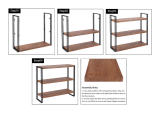Page is loading ...

Grill Table Kit
Get more project plans at BuildYella.com 1
OVERVIEW PACKAGE INCLUDES
TOOLS NEEDED
NOTES
Place the Table Top Assembly face down on a
at surface.
Position the Table Shelf Assembly at the
appropriate height for your grill (see Note 2).
1
2
3
4
1. Each leg will match with a pre-drilled hole. You may have
to rotate the legs and try them in different locations to get
the pre-drilled holes to align.
2. There are 3 locations for shelf height. Chose the one that
best ts your grill. A 22.5” diameter grill is the largest grill
that will t in this table.
3. A paving stone may be required to be placed under the
grill. Check manufacturer’s instructions for your specic grill.
4. Stain, seal or paint your grill table immediately for the best
protection from the elements.
5. These instructions are for the grill table only. Grill sold
separately.
Place four legs in corners as needed for pre-
drilled hole to align (see Note 1). Using socket
wrench or an adjustible wrench, secure in place
with bolts, washers and nuts.
Secure with bolts, washers, and nuts. Tighten
nuts with a socket wrench or an adjustable
wrench.
Socket Wrench OR an Adjustable Wrench
1x Table Top Assembly
1x Table Shelf Assembly
4x Legs
8x Carriage Bolts
8x Washers
8x Nuts
ASSEMBLY INSTRUCTIONS

Grill Table Kit
Get more project plans at BuildYella.com 2
IMPORTANT INFORMATION
YellaWood
®
brand pressure
treated products are treated with
preservatives (the “Preservatives”)
and preservative methods, and
technologies of unrelated third parties.
For details regarding the Preservatives,
methods, and technologies used by
Great Southern Wood Preserving,
Incorporated, see yellawood.com/
preservative or write us at P.O. Box
610, Abbeville, AL 36310. Ask dealer
for warranty details. For warranty
or for important handling and other
information concerning our products
including the appropriate Safety
Data Sheet (SDS), please visit us at
yellawood.com/warranties or write
us at P.O. Box 610, Abbeville, AL
36310. YellaWood
®
and the yellow tag
are federally registered trademarks
of Great Southern Wood Preserving,
Incorporated.
Great Southern Wood Preserving,
Incorporated makes no warranties
expressed or implied as to the tness
for a particular purpose of this plan.
• Consult the end tag to determine which preservative or preservative system was used in the treatment of that particular
product. YellaWood
®
brand products may be used in direct contact with aluminum building products when limited to
code-compliant construction applications that provide proper water drainage and do not allow the wood to be exposed
to standing water or water immersion.
• Use fasteners and other hardware that are in compliance with building codes for the intended use.
• Do not burn preserved wood.
• Wear a dust mask and goggles when cutting or sanding wood.
• Wear gloves when working with wood.
• Some preservative may migrate from the treated wood into soil/water or may dislodge from the treated wood surface
upon contact with skin.
• Wash exposed skin areas thoroughly.
• All sawdust and construction debris should be cleaned up and disposed of after construction.
• Wash work clothes separately from other household clothing before reuse.
• Preserved wood should not be used where it may come into direct or indirect contact with drinking water, except for
uses involving incidental contact such as fresh water docks and bridges.
• Do not use preserved wood under circumstances when the preservative may become a component of food, animal
feed or beehives.
• Do not use preserved wood as mulch.
• Only preserved wood that is visibly clean and free of surface residue should be used. If the wood is to be used in an
interior application and becomes wet during construction, it should be allowed to dry before being covered or enclosed.
• Mold growth can and does occur on the surface of many products, including untreated and treated wood, during
prolonged surface exposure to excessive moisture conditions. To remove mold from the treated wood surface, wood
should be allowed to dry. Typically, mild soap and water can be used to remove remaining surface mold. For more
information visit www.epa.gov.
• Projects should be designed and installed in accordance with federal, state and local building codes and ordinances
governing construction in your area, and in accordance with the National Design Specications (NDS) and the Wood
Handbook.
DISPOSAL
RECOMMENDATIONS
Preserved wood may be disposed of
in landlls or burned in commercial
or industrial incinerators or boilers in
accordance with federal, state and local
regulations.
Revised June 2018
/


